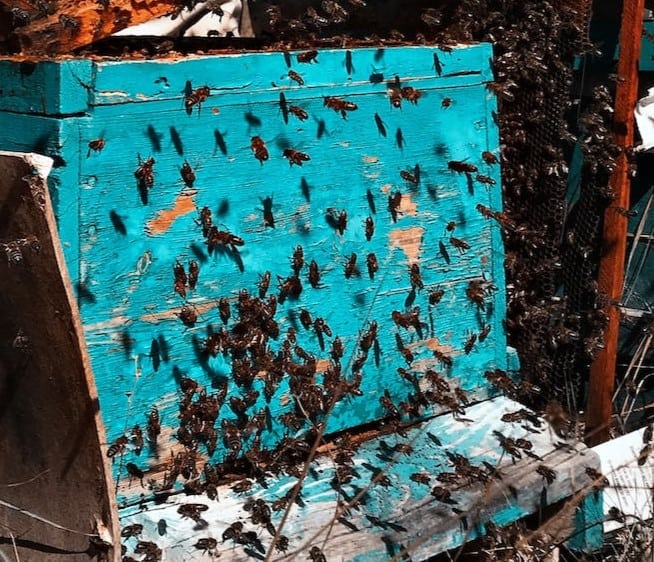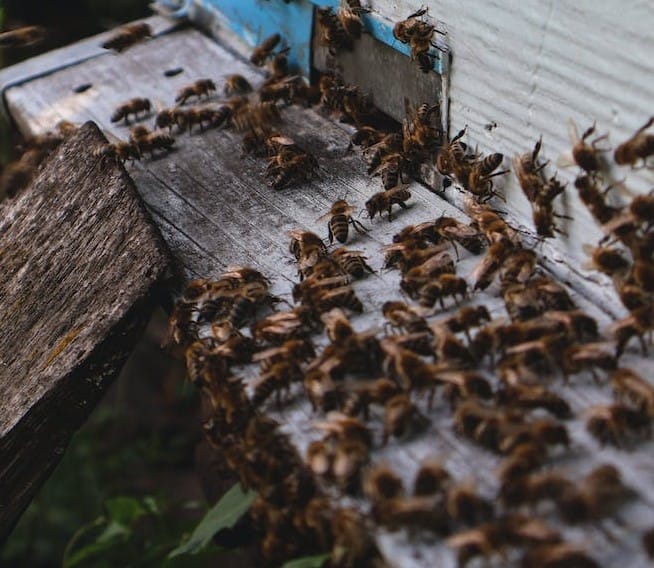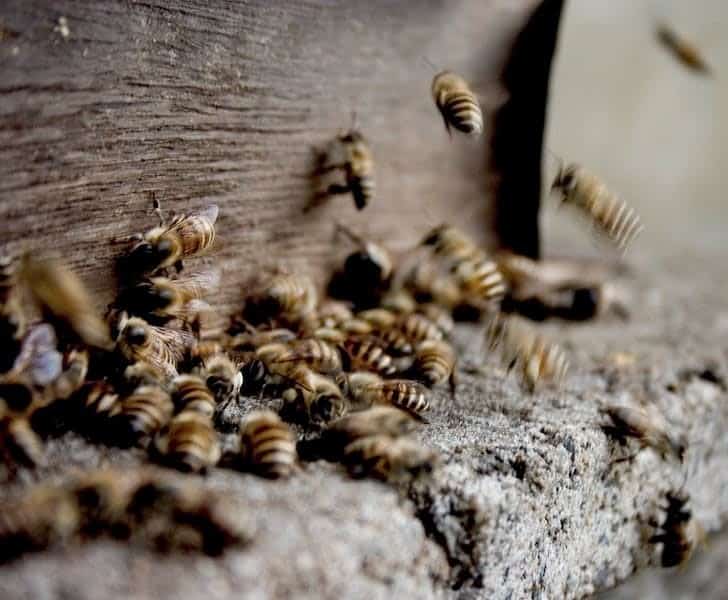Have you ever heard of bee bearding and wondered what it means? And when you have bearding bees, should you be concerned?
Inexperienced beekeepers often confuse bee bearding with bees preparing to swarm. While it may be a sign that bees are about to swarm, there is a difference.
In this blog post, we discover what bee bearding is and the reasons why honey bees beard. We will also explore its difference from swarming bees and what you should do with bearding bees.
What is Bee Bearding?

Bee bearding is the act of bees forming a beard-like cluster around the hive’s entrance. Bearding bees go out of the hive and create a formation resembling a beard.
When bees beard, they hang together as a group. In most cases, they cluster near the landing, or the bottom board, or in front of the hive.
It is a natural behavior by honeybees, especially during the summer months. It is both an intriguing and fascinating bee behavior.
Why do Bees Beard?
If you’ve ever seen a group of bees hanging outside a hive, forming what looks like a fuzzy beard, you may have wondered what they’re up to. This fascinating behavior serves a crucial purpose for the bees.
Temperature Control

The primary reason behind bee bearding is temperature regulation.
During the summer months, the insides of a hive may get too warm or highly humid. However, for successful brood development and honey production, bees need to maintain a specific environment inside the hive.
Honeybees are masters at temperature regulation. During warm days, they are busy flapping their wings tirelessly to help with air circulation and cool down the hive. Moisture inside the hive also evaporates, creating a cooling effect.
Yet, this undertaking alone may not be enough when the hives are subjected to extreme heat and humidity. Bees have to create some room inside the hives by going out. The decrease in the number of bees inside the hive helps decrease the heat load.
The bees would then beard outside the hive. Bearding bees hang at the hive entrance, fanning and pushing air inside the hive.
Lack of Space
Bearding also occurs when the hive lacks sufficient space to accommodate the increasing colony population. As more broods are produced and as worker bees grow, the need for additional room within the hive arises.
When the bees feel cramped, they gather and stay on the outside of the hive, forming a cluster of bees that resemble a beard. It helps free up some space in the hive for other bees that need shelter.
Sign of Swarming

In some cases, bearding can also be a sign that your bees are assembling to swarm. It is common knowledge in the beekeeping world that bees swarm when the hive is overpopulated.
Note, however, that not all bee bearding is a prelude to swarming. It is commonly a sign of swarming when taken together with other signs, such as the presence of queen cells and, in most cases, initiated by a queen bee.
Swarming is a natural behavior by honey bees to ensure the survival of the species.
When queen cells are in place, the queen starts to lay eggs. Worker bees feed the larvae with royal jelly to help them develop into potential queen bees. Eventually, the queen would stop laying eggs, allowing the colony to focus on the development and rearing of queens.
As new queens are being raised, the old queen realizes it is time for her to give way to a new queen that would reign over. The old queen leads a number of bees out of the hive.
This swarm of bees typically settles nearby, often in front of the hive’s entrance or the hive body or on a tree branch or other temporary resting place. When scout bees have found a new location for the swarm to establish, they start moving out to their new residence.
Bee Bearding vs. Bee Swarming
Both bee bearding and bee swarming highlight the incredible adaptability of honey bees. While both behaviors involve a mass of bees gathering together, it’s important to recognize the differences between the two behaviors.
The main thing to look out for to distinguish between bees that are bearding and bees that are getting ready to swarm is the location of the cluster of bees.
Bee bearding occurs when a number of bees spill out from the hive entrance, creating a mass of bees that resemble a beard. The bees usually stay on or around the hive’s entrance.
By gathering outside the hive and creating a space between their bodies, the bees allow air to circulate and provide evaporative cooling. This behavior helps to regulate the hive temperature and prevent overheating.
On the other hand, bee swarming is an entirely different phenomenon. It usually occurs during the warmer months when a healthy colony has reached a certain size and population.
Prior to swarming itself, the group of bees would often hang around the hive, which could often be mistaken as bee bearding. The difference here would lie in the fact that bees that are preparing to swarm are commonly seen flying around the hive.
Bee bearding is a temporary bee behavior aimed primarily at temperature regulation. On the other hand, bee swarming is a natural process that involves the formation of a new colony.
Both bee bearding and swarm preparations commonly occur during hot and humid weather. However, swarming would never happen on a hot summer day during a nectar dearth or when honey stores are low.
Before a bee swarms, it takes a fill of honey to keep him energized on his journey of finding a new home.

Why is it Important to Know the Difference?
During humid summer months, when swarming is most likely to occur, it is essential for beekeepers to monitor their hives regularly.
By being able to identify the signs of swarming, they can take timely and appropriate action to prevent swarming. This would redound down to preventing the loss of a vast majority of the members of the colony.
Being able to identify between bee bearding and the formation of bees prior to swarming would help beekeepers manage their hives. Before the bees swarm, beekeepers may be able to manage to keep their bees by splitting the hives.
Hence, it is important to identify the other signs of swarming. These include the existence of queen cells, a crowded brood nest, and the presence of the queen among the clustering bees.
What Should You Do with Bearding Bees?
Bearding is a natural behavior of honey bees, especially during the warmer months when the temperatures rise inside the hive.
Add Additional Brood Boxes and Honey Supers
When you observe bearding bees in your hives, the first thing to consider is the health of your colony. Check out the population of bees in your hive. An overly populated hive is more likely to engage in bearding behavior.
Not having adequate space to build comb and store honey would cause overcrowding. Consequently, the bees’ body heat would increase the temperature and humidity inside the hive.
If the colony population seems too much for your hive’s capacity, it might be time to provide additional brood boxes and honey supers.

Maintain Proper Ventilation
Seeing your bees bearding for a few hours is not a cause for concern if you have a strong colony.
However, it’s essential to maintain proper ventilation and airflow to provide enough cooler air circulation and maintain a balanced airflow.
It would also help avert any potential stress to the bees and prevent other hive issues.
Address Other Potential Stressors
For frequent occurrences or long periods of bearding, you might need to investigate further. Check for some possible factors (e.g., the surrounding environment, weather conditions, etc.) that cause your bees to stay outside of the hive.
Remember, extreme heat can cause excessive bearding. When such is the case, take measures to provide shade or extra ventilation.

Final Thoughts
When you see bees bearding in front of the hive, there is nothing to worry about. It is but a natural adaptive reaction of the bees to keep the hive’s internal temperature cool during hot and humid days.
In fact, you should be amazed that your bees can take care of themselves when they find it hot inside the hive.
Remember, crowded hives are more prone to engage in bearding behavior, so it may be necessary to provide more space. This can be done by adding a honey super or expanding the brood box.
Unless you see other signs, there is no fear of a bee swarm happening. But when you think that a swarm is going to happen soon, it may be time to split your hive.
By providing enough space and proper ventilation and addressing any potential stressors, you can help your honeybees thrive. Keeping an eye on your hive and understanding their behavior will enable you to intervene when necessary and support your bees’ well-being.
